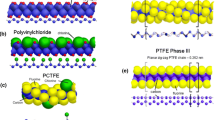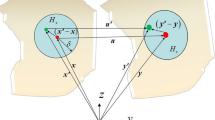Abstract
A model of a Maxwellian elastoplastic body is constructed to describe the behavior of polymethyl metacrylate (C5O2H8)n under loading. A principal feature of this model is supplementing the governing equations with the relaxation time of shear stresses in the form of a continuous dependence on parameters characterizing the state of the medium. The analytical form of the dependence is chosen with allowance for microstructural and mesostructural mechanisms of irreversible deformation. Another specific feature of the model is the equation of state of the medium, which includes the dependence of the internal energy on the first and second invariants of the strain tensor. Such an approach allows obtaining a unified mathematical description of all physical states of polymers. Particular attention is paid at the stage of model verification to comparisons of model predictions with experimental data for the temperature of the shock-compressed material and decay of the shock wave due to its interaction with overtaking and side rarefaction waves. This comparison shows that the model provides an adequate description of shock-wave processes in polymethyl metacrylate.
Similar content being viewed by others
References
G. M. Bartenev and S. Ya. Frenkel’, Physics of Polymers (Khimiya, Leningrad, 1990) [in Russian].
V. A. Stepanov, N. N. Peschanskaya, and V. V. Shpeizman, Strength and Relaxation in Solids (Nauka, Leningrad, 1984) [in Russian].
J. C. Maxwell, The Scientific Letters and Papers of James Clerk Maxwell (Cambrideg University Press, Cambridge, 2002).
W. Voigt, “Ueber innere Reibung fester Korper, insbesondere der Metalle,” Annalen der Physik 283, 671–693 (1892).
A. D. Mulliken and M. C. Boyce, “Mechanics of the Rate-Dependent Elastic-Plastic Deformation of Glassy Polymers from Low to High Strain Rates,” int. J. Solids Structures 43(5), 1331–1356 (2006).
R. F. Trunin, L. F. Gudarenko, M. V. Zhernokletov, and G. V. Simakov, Experimental Data on Shock-Wave Compression and Adiabatic Expansion of Condensed Substances (Inst. Exper. Phys., Russian Federal Nuclear Center, Sarov, 2001) [in Russian].
I. V. Kuz’mitskii, “Effect of Phase Transitions on the Shock-Wave Front in PMMA on the Wave Decay Rate and its Structure,” in Extreme States of Matter. Detonation. Shock Waves (Inst. Exper. Phys., Russian Federal Nuclear Center, Sarov, 2005), pp. 289–300) [in Russian].
T. R. Salyer, L. G. Hill, and L. Kin, “Confined PBX 9501 Gap Reinitiation Studies,” in Proc. Shock Compression of Condensed Matter Conf., 2009, pp. 245–248).
K. W. Schuler, J. W. Nunziato, and E. K. Walsh, “Recent Results in Nonlinear Viscoelastic Wave Propagation,” int. J. Solids Structures 9, 1237–1281 (1973).
L. M. Barker and R. E. Hollenbach, “Shock-Wave Studies of PMMA, Fused Silica, and Sapphire,” J. Appl. Phys. 41(10), 4208–4226 (1970).
K. W. Schuler, “Propagation of Steady Shock Waves in Polymethil Methacrylate,” J. Mech. Phys. Solids 18, 277–293 (1970).
R. Menikoff, “Constitutive Model for Polymethyl Methacrylate at High Pressure,” J. Appl. Phys. 96(12), 7696–7704 (2004).
L. A. Merzhievskii and A. D. Resnyanskii, “Shock-Wave Processes in Metals,” Fiz. Goreniya Vzryva 20(5), 114–122 (1984) [Combust., Expl., Shock Waves 20 (5), 580–586 (1984)].
S. K. Godunov, Elements of Mechanics of Continuous Media (Nauka, Moscow, 1978) [in Russian].
Ya. B. Zel’dovich and Yu. P. Raizer, Physics of Shock Waves and High-Temperature Hydrodynamic Phenomena (Fizmatgiz, Moscow, 1963; Academic Press, New York, 1967).
V. N. Zharkov and V. A. Kalinin, Equations of State for Solids at High Pressures and Temperatures (Nauka, Moscow, 1968) [in Russian].
A. V. Bushman and V. E. Fortov, “Models of the Equation of State of Matter,” Usp. Fiz. Nauk 140(2), 177–232 (1983).
G. V. Kozlov and D. S. Sanditov, Anharmonic Effects and Physicomechanical Properties of Polymers (Nauka, Novosibirsk, 1994) [in Russian].
A. V. Bushman, M. V. Zhernokletov, I. V. Lomonosov, et al., “Study of Plexiglas and Teflon in Waves of Repeated Shock Compression and Isentropic Unloading. Equation of State of Polymers at High Energy densities,” Dokl. Ross. Akad. Nauk 329(5), 581–584 (1993).
K. V. Khishchenko, “Temperature and Heat Capacity of Polymethyl Metacrylate behind the Front of Strong Shock Waves,” Teplofiz. Vys. Temp. 35(6), 1002–1005 (1997).
L. A. Merzhievskii, “Simulation of the Dynamic Compression of Polycrystalline Al2O3,” Fiz. Goreniya Vzryva 34(6), 85–94 (1998) [Combust., Expl., Shock Waves 34 (6), 679–687 (1988)].
C. E. Morris, J. N. Fritz, and R. G. McQueen, “The Equation of State of Polytetrafluoroethylene to 80 GPa,” J. Chem. Phys. 80(10), (1984).
C. Bauwens-Crowet, “The Compression Yield Behaviour of Polymethyl Methacrylate over a Wide Range of Temperatures and Strain-Rates,” J. Mater. Sci. 8, 968–979 (1973).
J. Richeton, L. Daridon, and Y. Remond, “A Formulation of the Cooperative Model for the Yield Stress of Amorphous Polymers for a Wide Range of Strain Rates and Temperatures,” Polymer 46, 6035–6043 (2005).
V. A. Bershtein, V. M. Egorov, and Yu. A. Emel’yanov, “Interrelation of Principal Relaxation Transitions in Polymers,” Vysokomol. Soed. (A) XXVII(11), 2451–2456 (1985).
L. A. Merzhievskii and S. A. Shamonin, “Construction of the Time Dependence of the Relaxation of Tangential Stresses on the State Parameters of a Medium,” Prikl. Mekh. Tekh. Fiz. 21(5), 170–179 (1980) [Appl. Mech. Tech. Phys. 21 (5), 716–724 (1980)].
N. A. Fleck, W. J. Stronge, and J. H. Liu, “High Strain-Rate Response of Polycarbonate and Polymethyl Methacrylate,” Proc. Roy. Soc. London A 429, 459–479 (1990).
S. C. Chou, K. D. Robertson, and J. H. Rainey, “The Effect of Strain Rate and Heat Developed during Deformation on the Stress-Strain Curve of Plastics,” Exp. Mech. 13(10), 422–432 (1973).
L. F. Gudarenko, M. V. Zhernokletov, S. I. Kirshanov, et al., “Properties of Shock-Compressed Carbogal. Equations of State for Carbogal and Plexiglas,” Fiz. Goreniya Vzryva 40(3), 104–116 (2004) [Combust., Expl., Shock Waves 40 (3), 344–355 (2004)].
S. B. Kormer, “Optical Study of Properties of Shock-Compressed Condensed Dielectrics,” Usp. Fiz. Nauk 94(4), 641–687 (1968).
S. A. Bordzilovskii and S. M. Karakhanov, “Measurement of the Brightness Temperature and Related Optical Characteristics of Shock-Compressed Polymethyl Metacrylate at 35 GPa,” in Lavrent’ev Readings on Mathematics, Mechanics, and Physics, Proc. VII Int. Conf., Novosibirsk, 2010, pp. 196–197.
Z. Rosenberg and Y. Parton, “Direct Measurement of Temperature in Shock-Loaded Polymethylmethacrylate with Very Thin Copper Thermistors,” J. Appl. Phys. 56(7), 1921–1926 (1984).
L. A. Merzhievskii and A. D. Resnyanskii, “Selecting a Model to Describe the Attenuation of Shock Waves in Metals,” Fiz. Goreniya Vzryva 19(1), 99–105 (1983) [Combust., Expl., Shock Waves 19 (1), 94–99 (1983)].
T. P. Liddiard, Jr., “The Compression of Polymethyl Methacrylate by Low Amplitude ShockWaves,” in Proc. of Fourth Symp. on Detonation (1965), pp. 214–221.
N. K. Bourne, A. M. Milne, and R. A. Biers, “Measurement of the Pressure Pulse from a Detonating Explosive,” J. Phys. D: Appl. Phys. 38, 1984–1988 (2005).
Author information
Authors and Affiliations
Corresponding author
Additional information
Original Russian Text © L.A. Merzhievskii, M.S. Voronin.
__________
Translated from Fizika Goreniya i Vzryva, Vol. 48, No. 2, pp. 113–123, March–April, 2012.
Rights and permissions
About this article
Cite this article
Merzhievskii, L.A., Voronin, M.S. Modeling of shock-wave deformation of polymethyl metacrylate. Combust Explos Shock Waves 48, 226–235 (2012). https://doi.org/10.1134/S0010508212020128
Received:
Published:
Issue Date:
DOI: https://doi.org/10.1134/S0010508212020128




